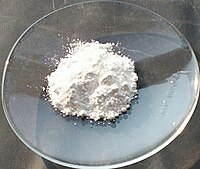
Photo from wikipedia
Although ginseng leaf is a good source of health-beneficial phytochemicals, such as polyphenols and ginsenosides, few studies have focused on the variation in compounds and bioactivities during leaf thermal processing.… Click to show full abstract
Although ginseng leaf is a good source of health-beneficial phytochemicals, such as polyphenols and ginsenosides, few studies have focused on the variation in compounds and bioactivities during leaf thermal processing. The efficiency of far-infrared irradiation (FIR) between 160 °C and 200 °C on the deglycosylation of bioactive compounds in ginseng leaves was analyzed. FIR treatment significantly increased the total polyphenol content (TPC) and kaempferol production from panasenoside conversion. The highest content or conversion ratio was observed at 180 °C (FIR-180). Major ginsenoside contents gradually decreased as the FIR temperature increased, while minor ginsenoside contents significantly increased. FIR exhibited high efficiency to produce dehydrated minor ginsenosides, of which F4, Rg6, Rh4, Rk3, Rk1, and Rg5 increased to their highest levels at FIR-190, by 278-, 149-, 176-, 275-, 64-, and 81-fold, respectively. Moreover, significantly increased antioxidant activities were also observed in FIR-treated leaves, particularly FIR-180, mainly due to the breakage of phenolic polymers to release antioxidants. These results suggest that FIR treatment is a rapid and efficient processing method for producing various health-beneficial bioactive compounds from ginseng leaves. After 30 min of treatment without leaf burning, FIR-190 was the optimum temperature for producing minor ginsenosides, whereas FIR-180 was the optimum temperature for producing polyphenols and kaempferol. In addition, the results suggested that the antioxidant benefits of ginseng leaves are mainly due to polyphenols rather than ginsenosides.
Journal Title: Molecules
Year Published: 2022
Link to full text (if available)
Share on Social Media: Sign Up to like & get
recommendations!